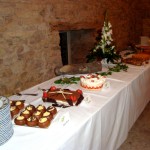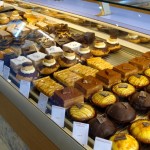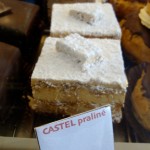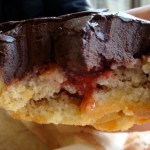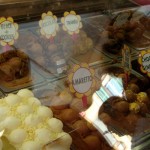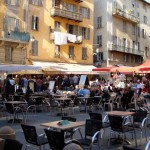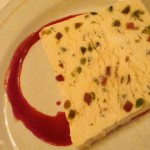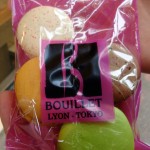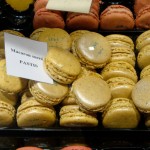France
French Délices Part 5: Wedding Bliss
It was about 12:30am– many hours into the wedding reception of good friends at a château in southern France. I was busy working on my substantial cheese course as a procession of waiters carrying fancy giant pastries, cakes, and puddings began to wind its way between our tables and into a dedicated dessert room.  I sneaked over to this magical chamber to check out the spread before the other guests could descend upon it.  And what wonders did I see– 17 (count ’em) different delights! The pièce de résistance was a traditional French wedding croquembouche, a tower of profiteroles stuck together with caramel and decorated with candies and sparklers.  My cup, it overfloweth-ed!
French Délices Part 4: Pastry Passion
It was my 21st birthday, and I was studying in Aix-en-Provence. The program had just started, and I didn’t know anyone yet, so who cared about my little-ole’ big 2-1? I turned to our local patisserie, Le Pavé du Roy, to ease my sorrow. It was the castel praliné that caught my eye– square, powdered-sugary, layered, and creamy-looking, would it be any good? It wasn’t my type– there wasn’t a hint of chocolate or fruit, but dang, I thought, I’m 21, maybe I should try something new? I stood outside that shop and took my first bite of utter heaven– layers of pastry dough, crunchy meringue, and hazelnut cream sent my head spinning. One of my program mates called my name, but I couldn’t respond. I was in a pastry passion– my heart and soul were lost forever. When I got back to the States, I searched in vain for the castel praliné. I stopped in every French patisserie over the years to no avail. No one had even heard of it. And then a pastry chef at Almondine informed me that I would NEVER find the castel in this country because the sugar here is too coarse. Devastated, I bided my time until I could return to my long-lost love…
After ten endless years, I did come back. Would the castel be different? Would I be different? I worried. But when my castel and I were in each other’s presence again, there was no doubt that the love would be stronger than ever. After sating my desire, my head turned towards other temptations, such as a chocolate cakey delight and a chocolate-raspberry-pear hybrid. These were equally amazing.  I tried to explain in my now-limited French how much I adore the unassuming Le Pavé du Roy patisserie to the other patrons there. They gave me blank stares. Of course this place was good– there would be another revolution if every little hole-in-the-wall patisserie in every crappy town wasn’t good.
In my travels, I encountered some over-the-top fancy pastries, too, that were way outta my league. They looked like ottomans, and were almost scientific in their perfection. The ones from Richart were accompanied by geologic-like schematical diagrams, so that you could see cross sections of exactly what was in each masterpiece. They had serious names likes “Fire & Ice” and “Sun’s Zest.” After scratching my head a bit trying to read the pastry “maps,” I discovered the one I would have chosen had I grown an extra stomach: “Crisp Flavors,” made up of layers of green lemon and caramel mousses, caramel-infused madeleine cookies, almond nougat, salted butter caramel cream, and toasted almond dacquoise. Just writing this description made me feel faint– does anyone know where I put my smelling salts?
Final note: there is a specialty in Lyon called praline rouge, which you find topping many pastries. The first time I saw it, I attributed the red color to a fruit, but a pastry proprietor told me that it’s basically just nuts (usually almonds or hazelnuts) ground up with butter, sugar, and some red food coloring; she had no idea why this trend started, and they never use any color other than red. Weird. Also not that tasty, really, because it’s a little “one-note” and makes you crave raspberries for some reason…
If you ever find yourself in Aix-en-Provence, by the way, hie thyself to:
Le Pavé du Roy 9, cours d’Orbitelle T: +33 0442262281French Délices Part 3: Ice Cream and Gelato
Also a major player on the French dessert scene is the glace, or ice cream. Nice has a famous gelateria called Fenocchio, which, funnily enough, has a rival gelateria called Pinocchio. The rivalry converges at Place Rosetti in the Old Town, where Fenocchio has its flagship location while Pinocchio has two across the way from each other. We all benefit from ice cream wars, don’t we? I only went to Fenocchio, and what an abundance of flavors– 96 to be exact! Of the many delightful parfums, imagine verbena (a flower), beer, vanilla-rose-pepper, thyme, Coca-Cola, Grand Marnier, jasmin, and chocolate-ginger. French ice cream is delicious and often comes in the form of complicated and expensive sundaes. I saw a few in Nice that cost 25 Euros! Yes, they came with seven scoops of ice cream, several toppings, and whipped cream, and probably should be shared, but wow, what a price. I accidentally purchased one of these while asking for an iced coffee in Lyon. I said café glacé, which literally means “iced coffee,” and was brought a monster of a sundae featuring several scoops of coffee ice cream, cookies, nuts, and whipped cream for 8 Euros. It was expensive, but very satisfying. After consuming this, I became sleepy, so I then purchased a regular coffee. This is the kind of mindless eating and drinking that you get in France, and I wouldn’t have it any other way.
I also tried an iced nougat at Brasserie Georges in Lyon, just for scientific study. It really wasn’t tough or chewy like you’d imagine a real frozen chunk of nougat would be, but rather had that nutty flavor and candied fruit, but with a decidedly ice creamy texture. It was tasty and a nice antidote for a rich meal. Our evening was punctuated with the waiters firing up an old-timey barrel organ to play Happy Birthday, which would be followed by a baked Alaska-type dessert garnished with a live sparkler being placed in front of a lucky birthday boy or girl.
French Délices Part 2: Macaron Madness
Macarons are the little gemstones of the pastry world. They come in every color and flavor, and are highly sought-after.  Some of them are even come covered in sparkles! A stale one is so sad– you hold it delicately and take a tentative bite, then the cookie collapses into shards and dust, and you must console yourself with the tiny bit of filling that’s inside.  But a fresh one is a glorious contrast in textures, with meringue-almond cookies that are crisp on the outside and chewy on the inside. Then there’s the delicious filling, sometimes a cream base, sometimes more a fruit jelly base.
My favorite place in NYC to find a good macaron is Almondine, with locations in D.U.M.B.O. and Park Slope. I found that French pâtisseries offer so many more interesting flavors than just your average chocolate or strawberry. I saw mandarin orange, lychee, zucchini-mint, salted caramel, white peach-saffron, grapefruit, Earl Grey tea, green lemon-ginger, cola, rum-raisin, and marshmallow, to name a few. Perhaps French pastry chefs like to experiment as much with macarons as their American counterparts do with ice cream.
Here are a few samples from different places in Lyon:
I also learned about the existence of both savory macarons, like black olive, gorgonzola-sesame, and tomato-basil, and sweet and savory hybrids, like duck foie gras with apple-spice, pimento-pepper, and carrot-cumin. Maybe they would have been nice to try for anthropological reasons, but I had valuable stomach space to preserve!
French Délices Part 1: The Common Crèpe
I just returned from a wonderful trip to my dessert motherland, France. This blog cannot possibly express the extent of my insane reverence for the French people’s mastery of sugar and cream. They have dairy products we don’t even have words for in English, for Pete’s sake! All I can do is show you some examples of the many delights (or délices) I had along the way.
I begin with the humble crêpe. Maybe you’ve had one slathered with gel-like “strawberry” sauce at some crêperie in the Lower East Side. Or you’ve tried a specimen from one of seemingly countless NYC street fairs, or even at the Bastille Day festival put on by the French Institute. It’s fun to watch them use that little wooden wand to work their magic, isn’t it? And how wonderful that even the bad ones are pretty good, right?
We began with a forestière galette (ham, swiss cheese, and mushrooms) made with buckwheat flour. It was plump with filling– a nice amount, but not sickening– and we (perhaps erroneously) felt semi-healthy for getting something with a buckwheat base. Then we moved on to our lemon and sugar crêpe, made with generous squeezes of a lemon wedge (not that bottled stuff) and lots of sugar. Yes, you can get Nutella and whipped cream, but the simplicity (not to mention caloric savings) of lemon and sugar are heavenly. The secret seems to be in the repeated application of toppings after each fold of the crêpe. Our crêpe was warm, moist, refreshing, sweet, springy, and light. It was so juicy that the syrup dripped on my purse and leg, and, amazingly, also on my partner’s leg and shoe. It was pretty windy, but I guess I must chalk my messiness up to being in a crêpe daze. Adieu, perfect crêpes… until we meet again.
